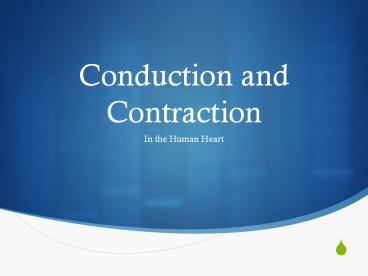The Basics of How the Heart Functions - PowerPoint PPT Presentation
Title:
The Basics of How the Heart Functions
Description:
The human heart is a complex organ that operates according to a coordinated series of electrical impulses and muscular contractions. A healthy heart contains two small chambers known as atria and two large chambers known as ventricles. The role of the atria is to force blood into the ventricles before they contract in order to maximize the amount of blood circulated by the ventricles to the lungs and the rest of the body. In order for the chambers to contract in the proper sequence, a collection of nerve tissue found at the top of the right atria referred to as the sinoatrial node emits stimuli at a regular interval. This contractile signal travels down through the heart terminating at the bottom of the left ventricle. Since the signal passes through the atria first, they are allowed to contract before the ventricles. Damage to either the electrical or muscular elements can cause severe cardiac damage or death. – PowerPoint PPT presentation
Number of Views:236
Learn more at:
http://www.ekgtechniciansalary.org/ekg-rhythms/
Title: The Basics of How the Heart Functions
1
Conduction and Contraction
- In the Human Heart
2
Purpose of the Heart
- Pump Blood
- Enable Oxygen and Nutrient Delivery
- Force Blood Into the Lungs
- Force Blood Through the Body
3
Cardiac Anatomy
- Four Total Chambers
- Smaller Atria on Top
- Larger Ventricles on Bottom
- Valves Prevent Backflow
- Nodes That Regulate Contractile Signals
- Nerves That Carry Contractile Signals
4
Cardiac Conduction
- Impulse Created in Sinoatrial Node
- Travels Through Atria Towards Ventricles
- Causes Contraction as it Travels
- Passes Through Atrioventricular Node
- Travels Along Nerves Through the Ventricles
5
Coordinated Contraction
- Gap Junctions Between Cells in a Chamber
- Provides a Means For Rapid Signal Transmission
- Special Nerves in Ventricles Known as Purkinje
Fibers - Carry Contractile Signals Faster Than Any Other
Nerve - All Cells in a Chamber Contract Together
6
Coordination
- Ensures That the Atria Contract Before the
Ventricles - Moves Blood in the Proper Direction
- Allows For Maximum Contractile Effort
- Increases Stroke Volume
- Delivers More Oxygen and Nutrients
7
Effects of Damage
- Improper Conduction
- Inefficient Contraction
- Decreased Oxygen and Nutrient Delivery
- Fatigue
- Death
8
Evaluation
- Electrocardiogram
- Echocardiogram
- Stress Tests
- Holter Monitoring
- Performed by EKG Technician
9
References
- http//www.ekgtechniciansalary.org/
- http//www.ekgtechniciansalary.org/ekg-rhythms/

